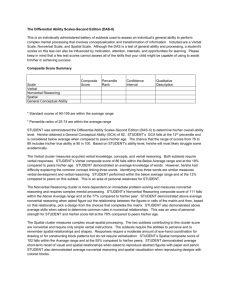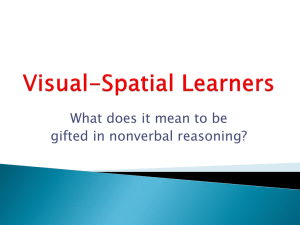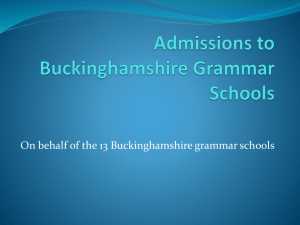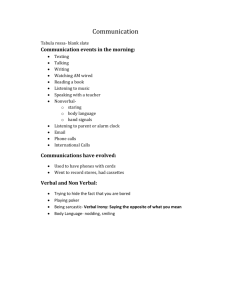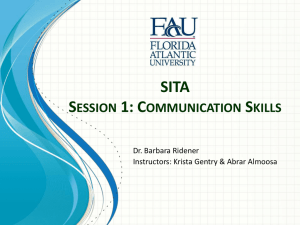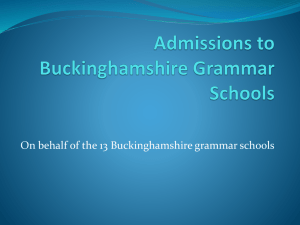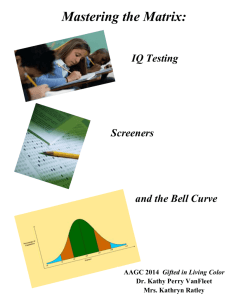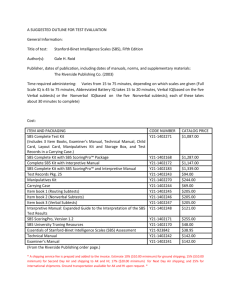8 Cognitive Template- Stanford Binet-V
advertisement
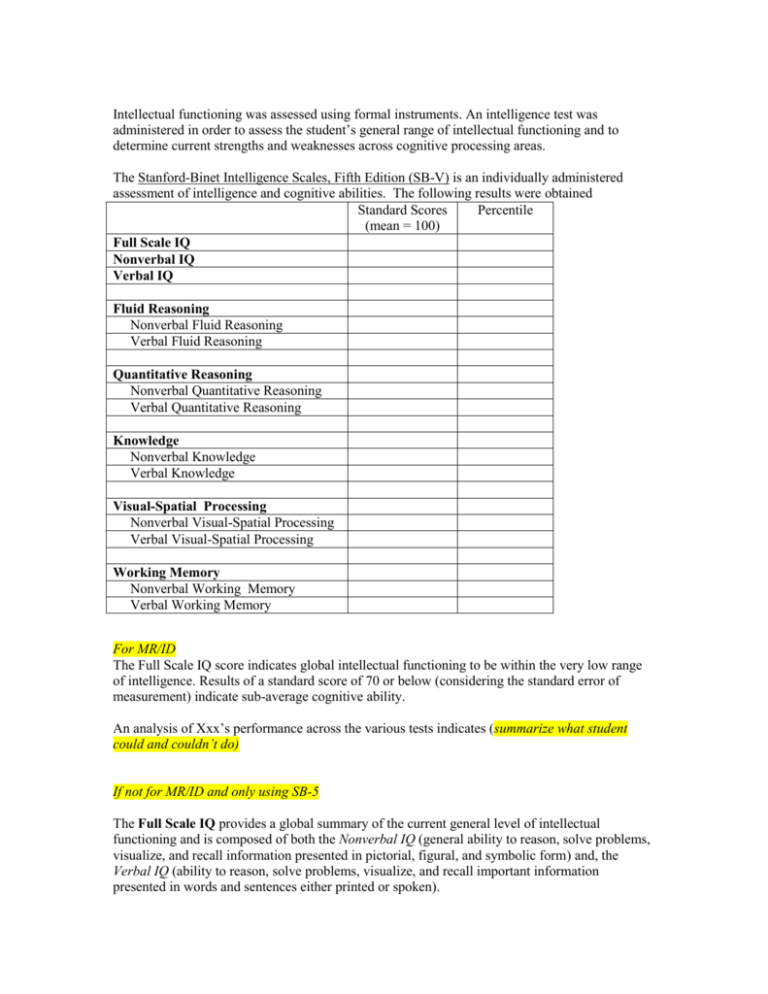
Intellectual functioning was assessed using formal instruments. An intelligence test was administered in order to assess the student’s general range of intellectual functioning and to determine current strengths and weaknesses across cognitive processing areas. The Stanford-Binet Intelligence Scales, Fifth Edition (SB-V) is an individually administered assessment of intelligence and cognitive abilities. The following results were obtained Standard Scores Percentile (mean = 100) Full Scale IQ Nonverbal IQ Verbal IQ Fluid Reasoning Nonverbal Fluid Reasoning Verbal Fluid Reasoning Quantitative Reasoning Nonverbal Quantitative Reasoning Verbal Quantitative Reasoning Knowledge Nonverbal Knowledge Verbal Knowledge Visual-Spatial Processing Nonverbal Visual-Spatial Processing Verbal Visual-Spatial Processing Working Memory Nonverbal Working Memory Verbal Working Memory For MR/ID The Full Scale IQ score indicates global intellectual functioning to be within the very low range of intelligence. Results of a standard score of 70 or below (considering the standard error of measurement) indicate sub-average cognitive ability. An analysis of Xxx’s performance across the various tests indicates (summarize what student could and couldn’t do) If not for MR/ID and only using SB-5 The Full Scale IQ provides a global summary of the current general level of intellectual functioning and is composed of both the Nonverbal IQ (general ability to reason, solve problems, visualize, and recall information presented in pictorial, figural, and symbolic form) and, the Verbal IQ (ability to reason, solve problems, visualize, and recall important information presented in words and sentences either printed or spoken). Xxx’s Full Scale IQ (is within normal limits/indicates a normative deficit/indicates a normative strength). OR Due to the variability in scores, the Full Scale IQ should be interpreted with caution. Fluid Reasoning is the ability to solve verbal and nonverbal problems using inductive or deductive reasoning. This cluster involves Nonverbal Fluid Reasoning (solving novel figural problems and identify sequences of pictured objects or matrix-type figural and geometric patterns and Verbal Fluid Reasoning (analyzing and explaining problems involving cause-effect connections in pictures, classification of objects, and identifying what is absurd in statements). Xxx’s performance indicates … (personalize this section based on your analysis of the student’s responses) Quantitative Reasoning is an individual’s facility with numbers and numerical problem solving, whether with word problems or with pictured relationships. This cluster is a combination of Nonverbal Quantitative Reasoning (demonstrating understanding of concepts such as “bigger” and “more” and/or solve addition problems and recognize numbers) and Verbal Quantitative Reasoning (counting, naming numbers, solving basic addition and subtraction problems and solving word problems). Xxx’s performance indicates … (personalize this section based on your analysis of the student’s responses) Crystallized Intelligence is a person’s accumulated fund of general information acquired at home, school, or work. This cluster involves Nonverbal Knowledge (performing everyday actions or demonstrating uses of common objects, identifying verbally and by pointing to an absurdity in a picture) Verbal Knowledge (identifying body parts, naming common objects, describing what is happening in a picture and defining words). Xxx’s performance indicates … (personalize this section based on your analysis of the student’s responses) Visual Processing measures an individual’s ability to see patterns, relationships, spatial orientations, or the gestalt whole among diverse pieces of visual display. This cluster is composed of Nonverbal Visual-Spatial Processing (solving spatial and figural problems presented as “puzzles” or completing patterns by moving plastic pieces into place) and Verbal Visual-Spatial Processing (placing a block on a specified part of a picture of a common object or scene). Xxx’s performance indicates … (personalize this section based on your analysis of the student’s responses) Working Memory is a class of memory processes in which diverse information stored in shortterm memory is inspected, sorted, or transformed. The cluster is composed of Nonverbal Working Memory (finding an object placed under one of two or three inverted cups and/or tapping blocks in a specified order after examiner has tapped blocks) and Verbal Working Memory (repeating verbatim sentences of varying length and/or recalling the order of the last word in a series of questions asked by the examiner). Xxx’s performance indicates … (personalize this section based on your analysis of the student’s responses)
